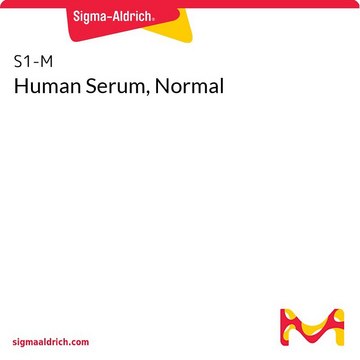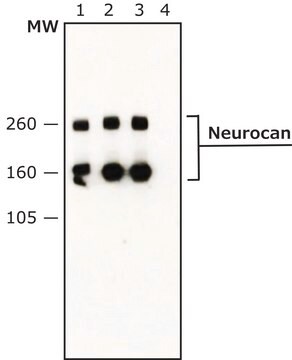Recommended Products
biological source
mouse
Quality Level
antibody form
purified immunoglobulin
antibody product type
primary antibodies
clone
monoclonal
species reactivity
chicken
manufacturer/tradename
Chemicon®
technique(s)
ELISA: suitable
immunoprecipitation (IP): suitable
western blot: suitable
isotype
IgG1
NCBI accession no.
UniProt accession no.
shipped in
dry ice
target post-translational modification
unmodified
Gene Information
human ... NCAN(1463)
General description
Specificity
Application
Western blot using anti-chick Neurocan (MAB5234). Samples are 1) Untreated embryonic chick brain extract, 2) chondroitinase-treated embryonic chick brain extract, 3) GST fusion proteins from the middle region of chick neurocan.
Samples must be digested with chondroitinase prior to running on SDS gels because undigested phosphacan is too large for most gels. Treatment is at a concentration of chondroitinase of 10U/mL in Tris-HCL pH 8.0. Make tissue or cell extract in 20-50mM Tris pH 7.6-8.0 with 0.15M NaCl in the presence of protease inhibitors. Add 1 microliter of enzyme to 30 microliters of extract and incubate 30 minutes at 37C. Then add SDS sample buffer, heat or boil sample as normal for SDS reducing samples.
Immunoprecipitation: 1 μg/mL
ELISA: 1 μg/mL, excellent for core protein, good for monomer
Immunocytochemistry: not tested
Immunohistochemistry: does not work on fixed samples, unfixed has not been tested.
Optimal working dilutions must be determined by the end user.
Physical form
Other Notes
Legal Information
Not finding the right product?
Try our Product Selector Tool.
Storage Class Code
12 - Non Combustible Liquids
WGK
WGK 2
Flash Point(F)
Not applicable
Flash Point(C)
Not applicable
Certificates of Analysis (COA)
Search for Certificates of Analysis (COA) by entering the products Lot/Batch Number. Lot and Batch Numbers can be found on a product’s label following the words ‘Lot’ or ‘Batch’.
Already Own This Product?
Find documentation for the products that you have recently purchased in the Document Library.
Our team of scientists has experience in all areas of research including Life Science, Material Science, Chemical Synthesis, Chromatography, Analytical and many others.
Contact Technical Service







